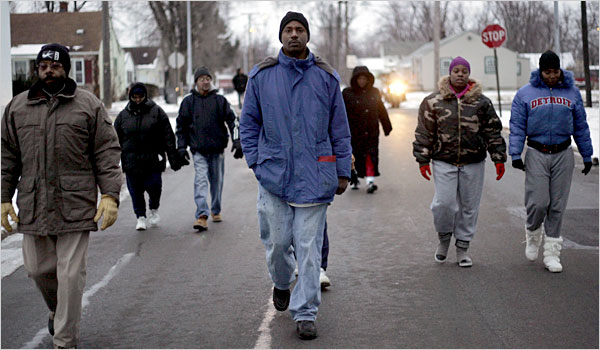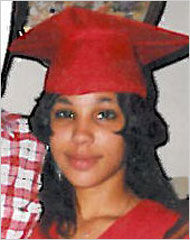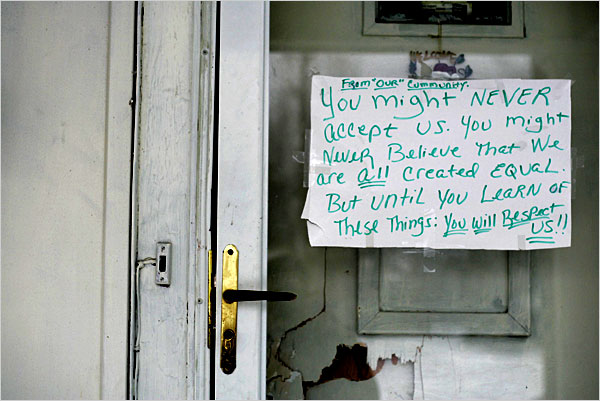| Want to send this page to a friend? Click on mail at the top of this window. |
More Special Reports |
| Posted January 30, 2008 |
| Police Shooting of Mother and Infant |
| Exposes a City's Racial Tension |
 |
|
J.D. POOLEY FOR THE NEW YORK TIMES |
|
| Ivory Austin, center, the brother of Tarika Wilson, was among those marcjing Saturday to protest her shooting death and the wounding of her 14-month-old son. |
By CHRISTOPHER MAAG |
LIMA, Ohio — The air of Southside is foul-smelling and thick, filled with fumes from an oil refinery and diesel smoke from a train yard, with talk of riot and recrimination, and with angry questions: Why is Tarika Wilson dead? Why did the police shoot her baby?
 |
| Tarika Wilson |
“This thing just stinks to high heaven, and the police know it,” said Jason Upthegrove, president of the Lima chapter of the N.A.A.C.P. “We’re not asking for answers anymore. We’re demanding them.”
Some facts are known. A SWAT team arrived at Ms. Wilson’s rented house in the Southside neighborhood early in the evening of Jan. 4 to arrest her companion, Anthony Terry, on suspicion of drug dealing, said Greg Garlock, Lima’s police chief. Officers bashed in the front door and entered with guns drawn, said neighbors who saw the raid.
Moments later, the police opened fire, killing Ms. Wilson, 26, and wounding her 14-month-old son, Sincere, Chief Garlock said. One officer involved in the raid, Sgt. Joseph Chavalia, a 31-year veteran, has been placed on paid administrative leave.
Beyond these scant certainties, there is mostly rumor and rage. The police refuse to give any account of the raid, pending an investigation by the Ohio attorney general.
 |
J.D. POOLEY FOR THE NEW YORK TIMES |
| Residents of Lima, Ohio, posted a sign at the house where Ms. Wilson, 26, was killed and her 14-month-old son was injured. |
Black people in Lima, from the poorest citizens to religious and business leaders, complain that rogue police officers regularly stop them without cause, point guns in their faces, curse them and physically abuse them. They say the shooting of Ms. Wilson is only the latest example of a long-running pattern of a few white police officers treating African-Americans as people to be feared.
“There is an evil in this town,” said C. M. Manley, 68, pastor of New Morning Star Missionary Baptist Church. “The police harass me. They harass my family. But they know that if something happens to me, people will burn down this town.”
Internal investigations have uncovered no evidence of police misconduct, Chief Garlock said. Still, local officials recognize that the perception of systemic racism has opened a wide chasm.
“The situation is very tense,” Mayor David J. Berger said. “Serious threats have been made. People are starting to carry weapons to protect themselves.”
Surrounded by farm country known for its German Catholic roots and conservative politics, Lima is the only city in the immediate area with a significant African-American population. Black families, including Mr. Manley’s, came to Lima in the 1940s and ’50s for jobs at what is now the Husky Energy Lima Refinery and other factories along the city’s southern border. Blacks make up 27 percent of the city’s 38,000 people, Mr. Berger said.
Many blacks still live downwind from the refinery. Many whites on the police force commute from nearby farm towns, where a black face is about as common as a twisty road. Of Lima’s 77 police officers, two are African-American.
“If I have any frustration when I retire, it’ll be that I wasn’t able to bring more racial balance to the police force,” said Chief Garlock, who joined the force in 1971 and has been chief for 11 years.
Tarika Wilson had six children, ages 8 to 1. They were fathered by five men, all of whom dealt drugs, said Darla Jennings, Ms. Wilson’s mother. But Ms. Wilson never took drugs nor allowed them to be sold from her house, said Tania Wilson, her sister.
“She took great care of those kids, without much help from the fathers, and the community respected her for that,” said Ms. Wilson’s uncle, John Austin.
Tarika Wilson’s companion, Mr. Terry, was the subject of a long-term drug investigation, Chief Garlock said, but Ms. Wilson was never a suspect.
During the raid, Ms. Wilson’s youngest son, Sincere, was shot in the left shoulder and hand. Three weeks after the shooting, he remains in fair condition, said a spokeswoman at Nationwide Children’s Hospital in Columbus.
Within minutes of the shooting, at around 8 p.m., 50 people gathered outside Ms. Wilson’s home and shouted obscenities at the police, neighbors said. The next day, 300 people gathered at the house and marched two miles to City Hall.
Many protesters believe they saw snipers atop police headquarters. The men on the roof were actually photographers, Chief Garlock said.
“The police can say whatever they want,” Tania Wilson said. “Even before they shot my sister, I didn’t trust them.”
Smaller marches have continued every week since the shooting. The N.A.A.C.P. will hold a public meeting on Saturday to air complaints about police brutality. The group will soon request that the Department of Justice investigate the police department and the Allen County prosecutor’s office, Mr. Upthegrove said.
Junior Cook was a neighbor of Tarika Wilson. He says that he watched from his front porch as the SWAT team raced across his front yard, and that seconds later he watched a police officer run from Ms. Wilson’s house carrying a bleeding baby in a blanket.
“The cops in Lima, they is racist like no tomorrow,” said Mr. Cook, 56. “Why else would you shoot a mother with a baby in her arms?”
Copyright 2008 The New York Times Company. Reprinted from The New York Times, National, of Wednesday, January 30, 2008.
| Wehaitians.com, the scholarly journal of democracy and human rights |
| More from wehaitians.com |